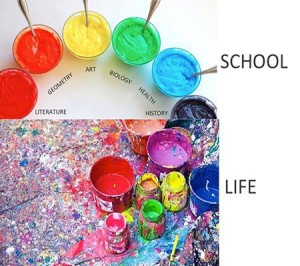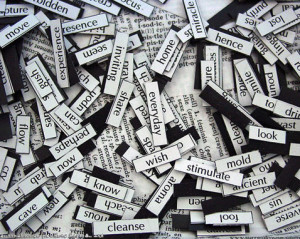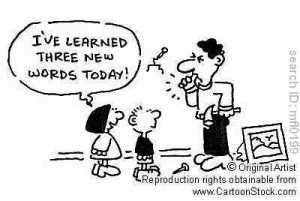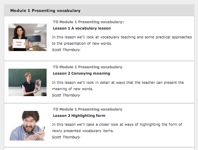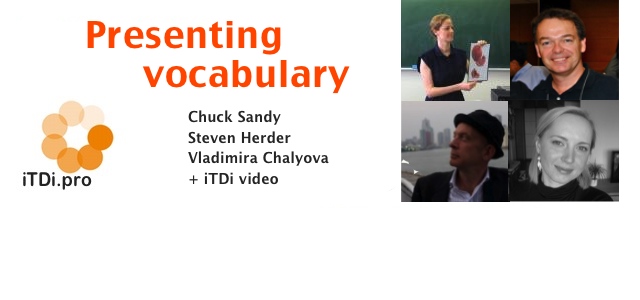
The Vocabulary Masters – Chuck Sandy
“Once we truly know that life is difficult — once we truly understand and accept it — then life is no longer difficult.” – M. Scott Peck
Substitute learning for life, say the new quote aloud, then read on:
When I heard my colleague-at-large, Rob Waring say several years ago at a conference that he’d walked into his university EFL class on the first day, handed his students a copy of the 570 word Academic Word List (AWL) and told them they were going to learn it, I thought this sounded both painful and a bit much. It turns out I was sort of right about it being painful but completely wrong about it being a bit much.
I found this out by trying it myself with two different university EFL classes I’d been charged with teaching: the highest-level freshman class at the university and the lowest level sophomore class.
On the first day in both classes, I announced our goal for the semester was to learn the academic world list, made that sound as exciting as I could, and then did what Rob had suggested. I passed out copies of the AWL and had students draw an x through the words they knew, place a check mark next to the words they sort of knew, and circle the words they didn’t know. I was pretty sure we had a real challenge on our hands when later I discovered that the best student in either class had circled only 119 words and that in both classes there were students who knew none of the words well enough to circle any.
The next thing we did in both classes was to talk about how best to go about learning these 570 words. I confessed that because I am not an expert on vocabulary learning, I’d need their help, and though they looked shocked about this, they willingly got into groups and came up with some great ideas that they shared with the class. I wrote all ideas on the board, and then we ranked them from most to least effective, most to least fun, and wildest to most boring. We had ideas that fit all categories, and I’d like to share some of the best with you.
Before I continue though, let me tell you the end of the story. In the next to the last class, we took a test on all 570 AWL words and in both classes more than half of the students scored 100% and though we’d mutually agreed to set the passing score at 80%, not a single student failed. When on the last day I passed the tests back and announced the results, both classes cheered. They’d done it! They knew they’d done it. They were vocabulary masters, and for some in the lowest level class, it was probably the first time probably they’d been masters of anything.
And how did this happen? Well, it wasn’t magic. It was them coming to embrace a difficult goal while slowly coming to realize (because of the disciplined time they put into reaching it) that it could be done. It was them taking ownership for how learning happened. It was me believing in them and then them believing in each other. It was good painful fun.
I won’t tell you about the weekly quizzes we did on AWL’s sublists or the flashcards we created on Quizlet or even how we used those cards to play rounds of Vocabulary Master, a flashcard game the students invented and decided to play the first 15 minutes of every class as they tested themselves on that weeks words, but I will tell you about ….
The Wall of WordsSince our classroom was graced on two sides by old fashioned black boards, the students decided to use these in every class to group AWL words in different ways. At first they decided to group the words by part of speech. Later they decided it might be more effective to come of with categories like Science, Environment, Politics, and Society to group the words into, even though they often had to defend and revise their decisions, which they came to enjoy. Students also used their cell phones to take photos of the word walls to keep for both their memory and at home study.
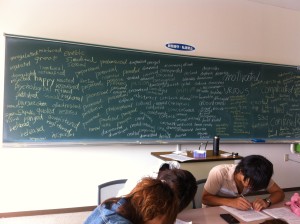

Hot 50 At some point students decided it would be useful to work in groups, choose one of the categories they’d created, and decide as a group what 50 words (out of 570) best fit that category and were most important to learn. They then presented their decisions to the class, and later we used these to decorate the room.

HOT 10 Song What would happen if we took 10 words from the Hot 50 poster, worked in groups and turned them into a song, the students wondered, so we tried that. This was one of the less successful activities but probably one that was the most fun and therefore very motivating after all those quizzes and flashcard games. Have a look hereto see a little clip of one group in the process of creating their song.
Human Vocabulary Well, how about if we spelled out some words with our bodies and had others guess the word? Or how about if we each became an adjective and acted that out? This was wildly fun, and a nice break from the other more traditional sorts of learning we were doing.


In addition to these class activities, students chose among several options such as writing a daily blog post using some of the vocabulary, writing collaborative quizzes to share with group members, keeping a vocabulary notebook, and writing their own personal dictionary for at home study. Meanwhile, they studied. They memorized. They quizzed themselves. They encouraged each other, and in the end, had some fun while putting up with the pain that was no longer pain because it had been accepted and became Vocabulary Masters.





